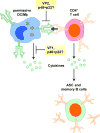Norovirus mechanisms of immune antagonism
- PMID: 26673810
- PMCID: PMC4821668
- DOI: 10.1016/j.coviro.2015.11.005
Norovirus mechanisms of immune antagonism
Abstract
Noroviruses are a leading cause of gastroenteritis outbreaks globally. Several lines of evidence indicate that noroviruses can antagonize or evade host immune responses, including the absence of long-lasting immunity elicited during a primary norovirus exposure and the ability of noroviruses to establish prolonged infections that are associated with protracted viral shedding. Specific norovirus proteins possessing immune antagonist activity have been described in recent years although mechanistic insight in most cases is limited. In this review, we discuss these emerging strategies used by noroviruses to subvert the immune response, including the actions of two nonstructural proteins (p48 and p22) to impair cellular protein trafficking and secretory pathways; the ability of the VF1 protein to inhibit cytokine induction; and the ability of the minor structural protein VP2 to regulate antigen presentation. We also discuss the current state of the understanding of host and viral factors regulating the establishment of persistent norovirus infections along the gastrointestinal tract. A more detailed understanding of immune antagonism by pathogenic viruses will inform prevention and treatment of disease.
Copyright © 2015 Elsevier B.V. All rights reserved.
Figures

Similar articles
-
Norovirus antagonism of B-cell antigen presentation results in impaired control of acute infection.Mucosal Immunol. 2016 Nov;9(6):1559-1570. doi: 10.1038/mi.2016.15. Epub 2016 Mar 23. Mucosal Immunol. 2016. PMID: 27007673 Free PMC article.
-
Norovirus pathogenesis: mechanisms of persistence and immune evasion in human populations.Immunol Rev. 2008 Oct;225:190-211. doi: 10.1111/j.1600-065X.2008.00680.x. Immunol Rev. 2008. PMID: 18837783 Review.
-
Norovirus Infection: Replication, Manipulation of Host, and Interaction with the Host Immune Response.J Interferon Cytokine Res. 2016 Apr;36(4):215-25. doi: 10.1089/jir.2015.0124. Epub 2016 Jan 27. J Interferon Cytokine Res. 2016. PMID: 27046239 Review.
-
A working model of how noroviruses infect the intestine.PLoS Pathog. 2015 Feb 27;11(2):e1004626. doi: 10.1371/journal.ppat.1004626. eCollection 2015 Feb. PLoS Pathog. 2015. PMID: 25723501 Free PMC article. No abstract available.
-
Mouse Norovirus Infection Reduces the Surface Expression of Major Histocompatibility Complex Class I Proteins and Inhibits CD8+ T Cell Recognition and Activation.J Virol. 2018 Aug 29;92(18):e00286-18. doi: 10.1128/JVI.00286-18. Print 2018 Sep 15. J Virol. 2018. PMID: 29976673 Free PMC article.
Cited by
-
No Clinical Symptom Experienced after Consumption of Berry Fruits with Positive RT-qPCR Signals of Human Norovirus.Pathogens. 2021 Jul 5;10(7):846. doi: 10.3390/pathogens10070846. Pathogens. 2021. PMID: 34357997 Free PMC article.
-
Norovirus: An Overview of Virology and Preventative Measures.Viruses. 2022 Dec 16;14(12):2811. doi: 10.3390/v14122811. Viruses. 2022. PMID: 36560815 Free PMC article. Review.
-
Interferon responses to norovirus infections: current and future perspectives.J Gen Virol. 2021 Oct;102(10):001660. doi: 10.1099/jgv.0.001660. J Gen Virol. 2021. PMID: 34698626 Free PMC article. Review.
-
Recent advances in understanding norovirus pathogenesis.J Med Virol. 2016 Nov;88(11):1837-43. doi: 10.1002/jmv.24559. Epub 2016 May 5. J Med Virol. 2016. PMID: 27110852 Free PMC article. Review.
-
Secretion of functional interferon by the type 3 secretion system of enteropathogenic Escherichia coli.Microb Cell Fact. 2024 Jun 1;23(1):163. doi: 10.1186/s12934-024-02397-y. Microb Cell Fact. 2024. PMID: 38824527 Free PMC article.
References
Publication types
MeSH terms
Substances
Grants and funding
LinkOut - more resources
Full Text Sources
Other Literature Sources
Medical

